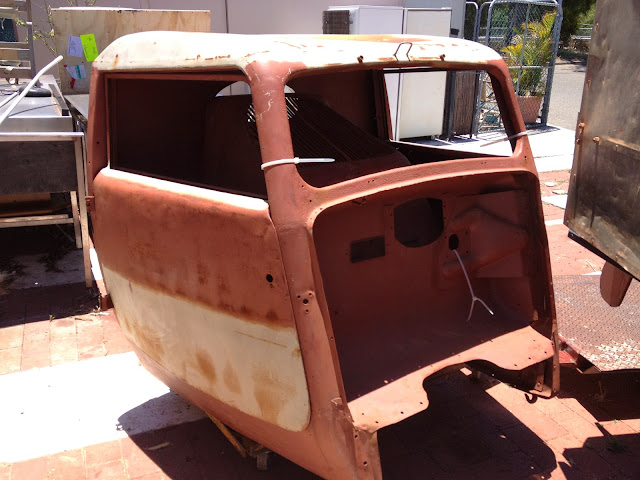
Welcome to my new blog. Let me introduce myself - my name in Paul and I live in Perth, Western Australia. I have long had an interest in arcane and odd vehicles. Maybe it's a family thing? My great uncle, Percy Markham, was an avid vintage car collector. He later donated his collection to the West Australian Museum, but in the 1990s the West Australian Government sold it off in dubious (criminal?) circumstances. To this day obtaining information about what was sold is nearly impossible.
http://www.heinkelscooter.blogspot.com.au/2011/06/percy-markham-collection.html
When I was 18 I bought my grandfather's 1963 EH Holden and drove it for a decade as it slowly deteriorated. In those days I simply did not have the money or technical skill to maintain it as I should. Sadly I was forced to sell when it became unsafe to drive; a decision I've always regretted.
When I turned 40 I bought myself a Balinese restored Vespa. It had its problems of course, but after a little bit of work it's been a surprisingly reliable little machine. More importantly, that little Vespa introduced me into the world of vintage scooters and motorcycles. The Vespa was soon joined by a 1954 Heinkel Tourist basketcase and a 1964 IWL scooter. Have blogged about these restoration projects here -
http://www.heinkelscooter.blogspot.com.au/2008/04/beginning-at-beginning.html The Troll is on the road but the Heinkel is still a box of bits four years on.
Before I could start on the Heinkel I was diverted to buy a 1958 Ariel Leader motorcycle.
http://www.heinkelscooter.blogspot.com.au/2010/01/there-was-movement-at-station.html
Last year I took the serious plunge of importing a 1958 DKW car from South Africa, which has brought me no end of pleasure.
http://www.heinkelscooter.blogspot.com.au/2011/10/importing-south-african-dkw.html
One would think that with all these projects and vehicles to maintain that it would be foolish to start on another mad venture. At least that's what my wife thinks! And she's right of course. I've barely made any progress on the Heinkel scooter and I do - eventually - want to get that finished. But then sometimes something just falls into your lap.
A year or so ago I was trolling through the '
restoration and salvage' pages of Australian eBay. It was not something I would normally look at but there had recently been a Goggomobil Dart project advertised there in error before being quickly withdrawn (or sold). It made me wonder if there might be other gems lurking there.

Anyway, I was searching for DKW parts and I got a hit. Actually, the wording of the advert was a little vague, 'Tempo Hanseat engine, two stroke, DKW, JLO.' This is a fairly common technique on eBay of including a range of related words to broaden the search results. Tempo Hanseat, I thought? That must be a mistake. The German Vidal and Son company of Hamburg had built Tempo speed tricycles from the 1920s through to 1956, but they were never imported into Australia.

To me the engine looked like a two cylinder DKW two-stroke from the 1930s. That was interesting, so I contacted the seller and he provided me some brief details about the parts he had - an engine, a radiator and an assortment of miscellaneous parts. He was fairly sure it came from a Tempo but he didn't know the details. At the end of the day though I let it pass. I had too many other things going on and really what was I going to with a Tempo engine?

Fast forward 18 months and I'm trolling through my emails and come across the Tempo engine correspondence. By this time the DKW had arrived and I was on the lookout for DKW parts - in very short supply in Australia - and I wondered if the Tempo seller, who had a family auto wrecker business, might also have DKW parts. So I emailed the seller. Unfortunately he did not have any DKW parts, but he did advise that he still had the Tempo engine if I wanted it. What's more, after some searching he'd managed to locate the engine, starter motor, clutch, gearbox, radiator, drive-train, steering, and petrol tank. It wasn't much to work with but if I was interested I could have it all for $100.
He also had an interesting tale to tell about its unlikely providence. The Tempo was bought out to Australia by a French emigre in the mid-1950s (the Tempo was built around 1953). He settled in Blackheath in the Blue Mountains, east of Sydney and used the Tempo as a farm and delivery vehicle for a number of years. The steep and hilly landscape of the Blue Mountains wasn't exactly the best environment for the Tempo, which easily became unbalanced when unloaded. The seller remembers seeing the Tempo tipped over on its nose on the roadside as a kid.

After a number of years and a couple of accidents the owner decided to sell the Tempo but there were no takers for such an eccentric vehicle so he ended up selling it to a wrecker in Katoomba in the 1960s. The wrecker stripped the vehicle of those mechanical parts that could potentially be reused - the engine, radiator, drive, petrol tank - and stored them for later. The cab was sawn from its tube chassis and tray, which was converted into a trailer and sold. The cab was scrapped.
So I obtained a bunch of parts from a Tempo. Not much to work with really, but its crazy opportunities like this that interest me. I enjoy the search, tracking down parts. It's going to be a long slow project that may or may not even get off the ground. But I'm want to try. So I have created this separate blog to track my progress. I'll still be using the Heinkel blog to publish my ongoing researches, museum visits and rallies.
http://www.heinkelscooter.blogspot.com.au/


























